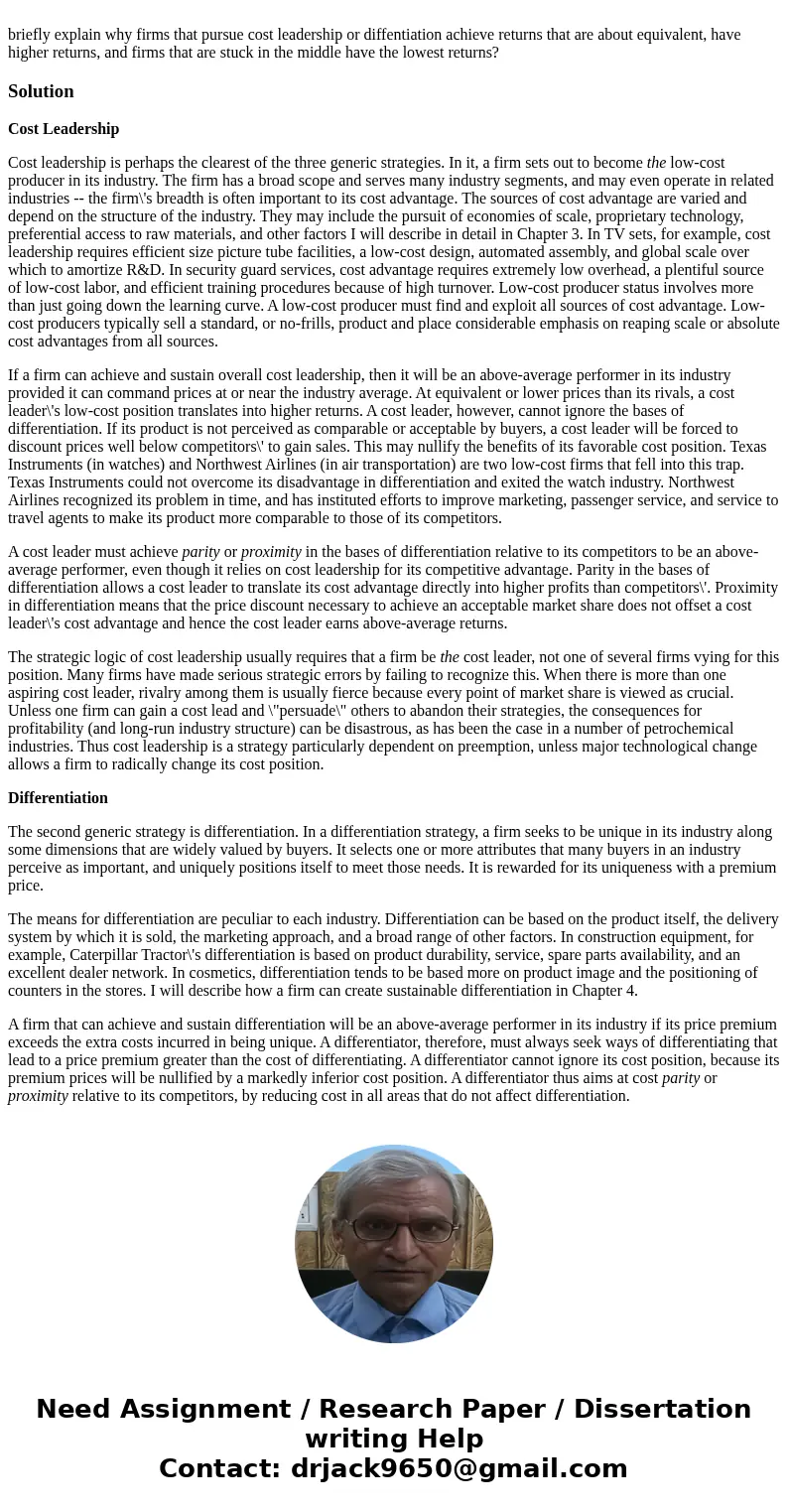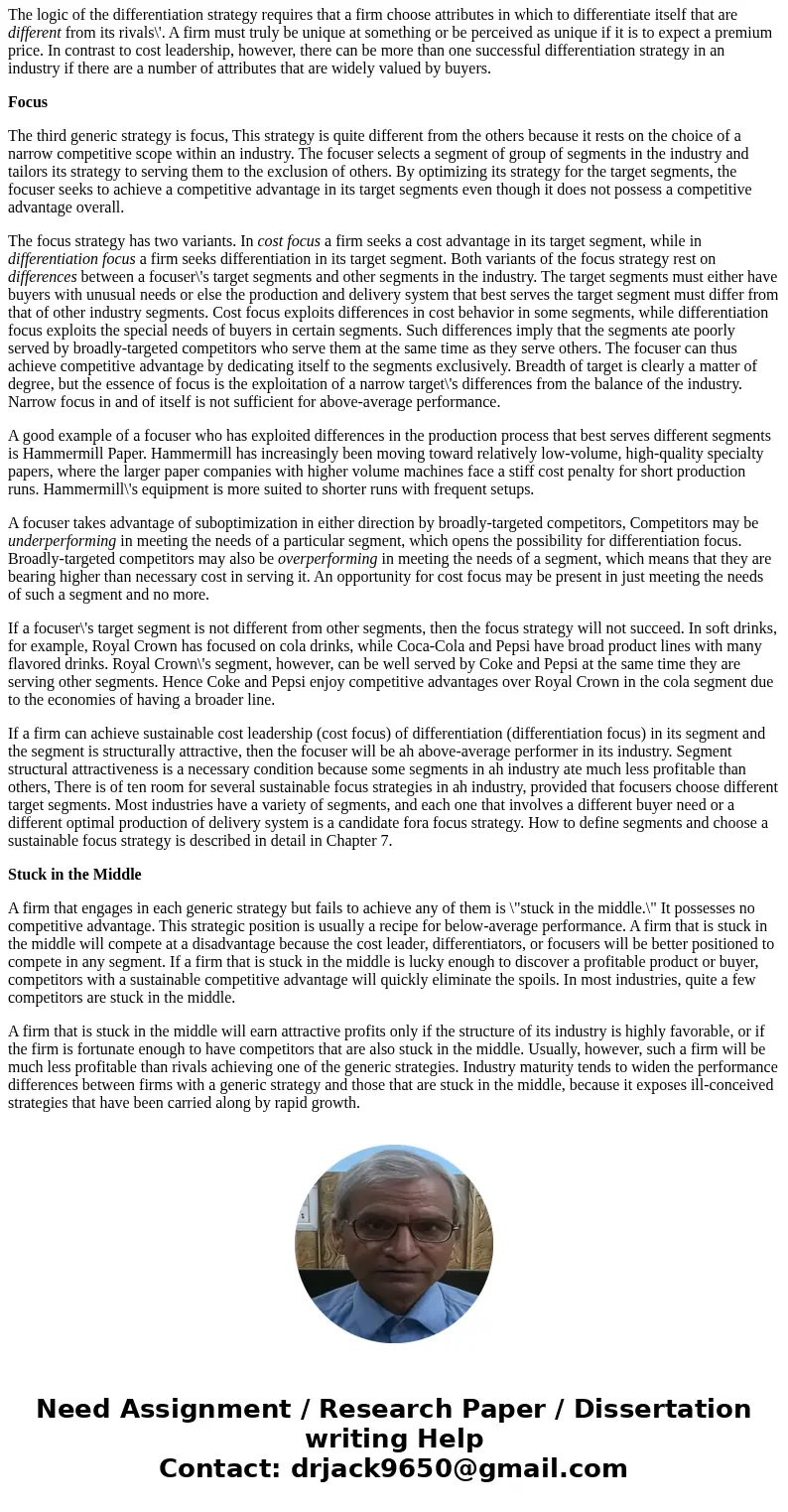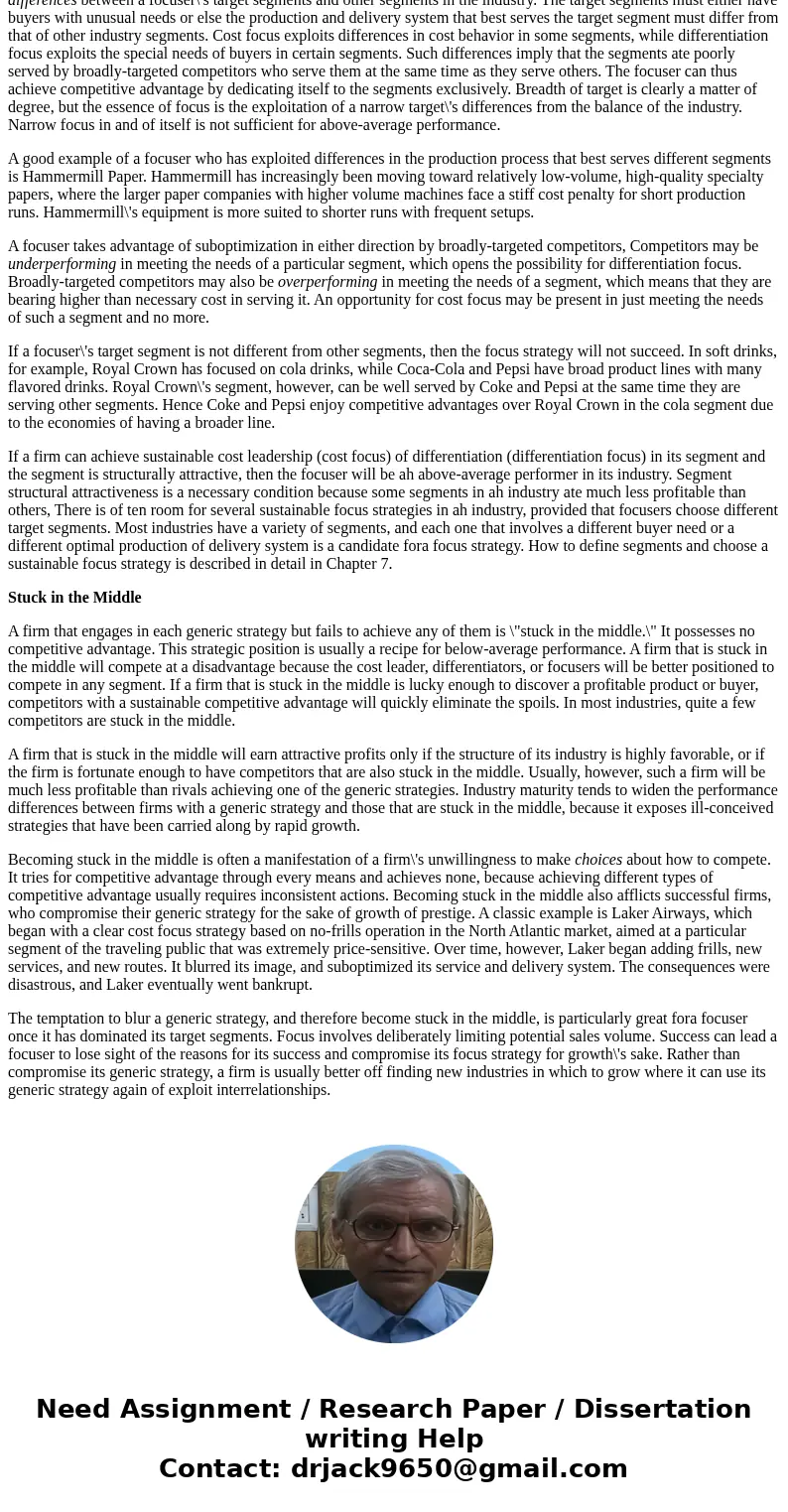briefly explain why firms that pursue cost leadership or dif
briefly explain why firms that pursue cost leadership or diffentiation achieve returns that are about equivalent, have higher returns, and firms that are stuck in the middle have the lowest returns?
Solution
Cost Leadership
Cost leadership is perhaps the clearest of the three generic strategies. In it, a firm sets out to become the low-cost producer in its industry. The firm has a broad scope and serves many industry segments, and may even operate in related industries -- the firm\'s breadth is often important to its cost advantage. The sources of cost advantage are varied and depend on the structure of the industry. They may include the pursuit of economies of scale, proprietary technology, preferential access to raw materials, and other factors I will describe in detail in Chapter 3. In TV sets, for example, cost leadership requires efficient size picture tube facilities, a low-cost design, automated assembly, and global scale over which to amortize R&D. In security guard services, cost advantage requires extremely low overhead, a plentiful source of low-cost labor, and efficient training procedures because of high turnover. Low-cost producer status involves more than just going down the learning curve. A low-cost producer must find and exploit all sources of cost advantage. Low-cost producers typically sell a standard, or no-frills, product and place considerable emphasis on reaping scale or absolute cost advantages from all sources.
If a firm can achieve and sustain overall cost leadership, then it will be an above-average performer in its industry provided it can command prices at or near the industry average. At equivalent or lower prices than its rivals, a cost leader\'s low-cost position translates into higher returns. A cost leader, however, cannot ignore the bases of differentiation. If its product is not perceived as comparable or acceptable by buyers, a cost leader will be forced to discount prices well below competitors\' to gain sales. This may nullify the benefits of its favorable cost position. Texas Instruments (in watches) and Northwest Airlines (in air transportation) are two low-cost firms that fell into this trap. Texas Instruments could not overcome its disadvantage in differentiation and exited the watch industry. Northwest Airlines recognized its problem in time, and has instituted efforts to improve marketing, passenger service, and service to travel agents to make its product more comparable to those of its competitors.
A cost leader must achieve parity or proximity in the bases of differentiation relative to its competitors to be an above-average performer, even though it relies on cost leadership for its competitive advantage. Parity in the bases of differentiation allows a cost leader to translate its cost advantage directly into higher profits than competitors\'. Proximity in differentiation means that the price discount necessary to achieve an acceptable market share does not offset a cost leader\'s cost advantage and hence the cost leader earns above-average returns.
The strategic logic of cost leadership usually requires that a firm be the cost leader, not one of several firms vying for this position. Many firms have made serious strategic errors by failing to recognize this. When there is more than one aspiring cost leader, rivalry among them is usually fierce because every point of market share is viewed as crucial. Unless one firm can gain a cost lead and \"persuade\" others to abandon their strategies, the consequences for profitability (and long-run industry structure) can be disastrous, as has been the case in a number of petrochemical industries. Thus cost leadership is a strategy particularly dependent on preemption, unless major technological change allows a firm to radically change its cost position.
Differentiation
The second generic strategy is differentiation. In a differentiation strategy, a firm seeks to be unique in its industry along some dimensions that are widely valued by buyers. It selects one or more attributes that many buyers in an industry perceive as important, and uniquely positions itself to meet those needs. It is rewarded for its uniqueness with a premium price.
The means for differentiation are peculiar to each industry. Differentiation can be based on the product itself, the delivery system by which it is sold, the marketing approach, and a broad range of other factors. In construction equipment, for example, Caterpillar Tractor\'s differentiation is based on product durability, service, spare parts availability, and an excellent dealer network. In cosmetics, differentiation tends to be based more on product image and the positioning of counters in the stores. I will describe how a firm can create sustainable differentiation in Chapter 4.
A firm that can achieve and sustain differentiation will be an above-average performer in its industry if its price premium exceeds the extra costs incurred in being unique. A differentiator, therefore, must always seek ways of differentiating that lead to a price premium greater than the cost of differentiating. A differentiator cannot ignore its cost position, because its premium prices will be nullified by a markedly inferior cost position. A differentiator thus aims at cost parity or proximity relative to its competitors, by reducing cost in all areas that do not affect differentiation.
The logic of the differentiation strategy requires that a firm choose attributes in which to differentiate itself that are different from its rivals\'. A firm must truly be unique at something or be perceived as unique if it is to expect a premium price. In contrast to cost leadership, however, there can be more than one successful differentiation strategy in an industry if there are a number of attributes that are widely valued by buyers.
Focus
The third generic strategy is focus, This strategy is quite different from the others because it rests on the choice of a narrow competitive scope within an industry. The focuser selects a segment of group of segments in the industry and tailors its strategy to serving them to the exclusion of others. By optimizing its strategy for the target segments, the focuser seeks to achieve a competitive advantage in its target segments even though it does not possess a competitive advantage overall.
The focus strategy has two variants. In cost focus a firm seeks a cost advantage in its target segment, while in differentiation focus a firm seeks differentiation in its target segment. Both variants of the focus strategy rest on differences between a focuser\'s target segments and other segments in the industry. The target segments must either have buyers with unusual needs or else the production and delivery system that best serves the target segment must differ from that of other industry segments. Cost focus exploits differences in cost behavior in some segments, while differentiation focus exploits the special needs of buyers in certain segments. Such differences imply that the segments ate poorly served by broadly-targeted competitors who serve them at the same time as they serve others. The focuser can thus achieve competitive advantage by dedicating itself to the segments exclusively. Breadth of target is clearly a matter of degree, but the essence of focus is the exploitation of a narrow target\'s differences from the balance of the industry. Narrow focus in and of itself is not sufficient for above-average performance.
A good example of a focuser who has exploited differences in the production process that best serves different segments is Hammermill Paper. Hammermill has increasingly been moving toward relatively low-volume, high-quality specialty papers, where the larger paper companies with higher volume machines face a stiff cost penalty for short production runs. Hammermill\'s equipment is more suited to shorter runs with frequent setups.
A focuser takes advantage of suboptimization in either direction by broadly-targeted competitors, Competitors may be underperforming in meeting the needs of a particular segment, which opens the possibility for differentiation focus. Broadly-targeted competitors may also be overperforming in meeting the needs of a segment, which means that they are bearing higher than necessary cost in serving it. An opportunity for cost focus may be present in just meeting the needs of such a segment and no more.
If a focuser\'s target segment is not different from other segments, then the focus strategy will not succeed. In soft drinks, for example, Royal Crown has focused on cola drinks, while Coca-Cola and Pepsi have broad product lines with many flavored drinks. Royal Crown\'s segment, however, can be well served by Coke and Pepsi at the same time they are serving other segments. Hence Coke and Pepsi enjoy competitive advantages over Royal Crown in the cola segment due to the economies of having a broader line.
If a firm can achieve sustainable cost leadership (cost focus) of differentiation (differentiation focus) in its segment and the segment is structurally attractive, then the focuser will be ah above-average performer in its industry. Segment structural attractiveness is a necessary condition because some segments in ah industry ate much less profitable than others, There is of ten room for several sustainable focus strategies in ah industry, provided that focusers choose different target segments. Most industries have a variety of segments, and each one that involves a different buyer need or a different optimal production of delivery system is a candidate fora focus strategy. How to define segments and choose a sustainable focus strategy is described in detail in Chapter 7.
Stuck in the Middle
A firm that engages in each generic strategy but fails to achieve any of them is \"stuck in the middle.\" It possesses no competitive advantage. This strategic position is usually a recipe for below-average performance. A firm that is stuck in the middle will compete at a disadvantage because the cost leader, differentiators, or focusers will be better positioned to compete in any segment. If a firm that is stuck in the middle is lucky enough to discover a profitable product or buyer, competitors with a sustainable competitive advantage will quickly eliminate the spoils. In most industries, quite a few competitors are stuck in the middle.
A firm that is stuck in the middle will earn attractive profits only if the structure of its industry is highly favorable, or if the firm is fortunate enough to have competitors that are also stuck in the middle. Usually, however, such a firm will be much less profitable than rivals achieving one of the generic strategies. Industry maturity tends to widen the performance differences between firms with a generic strategy and those that are stuck in the middle, because it exposes ill-conceived strategies that have been carried along by rapid growth.
Becoming stuck in the middle is often a manifestation of a firm\'s unwillingness to make choices about how to compete. It tries for competitive advantage through every means and achieves none, because achieving different types of competitive advantage usually requires inconsistent actions. Becoming stuck in the middle also afflicts successful firms, who compromise their generic strategy for the sake of growth of prestige. A classic example is Laker Airways, which began with a clear cost focus strategy based on no-frills operation in the North Atlantic market, aimed at a particular segment of the traveling public that was extremely price-sensitive. Over time, however, Laker began adding frills, new services, and new routes. It blurred its image, and suboptimized its service and delivery system. The consequences were disastrous, and Laker eventually went bankrupt.
The temptation to blur a generic strategy, and therefore become stuck in the middle, is particularly great fora focuser once it has dominated its target segments. Focus involves deliberately limiting potential sales volume. Success can lead a focuser to lose sight of the reasons for its success and compromise its focus strategy for growth\'s sake. Rather than compromise its generic strategy, a firm is usually better off finding new industries in which to grow where it can use its generic strategy again of exploit interrelationships.



 Homework Sourse
Homework Sourse